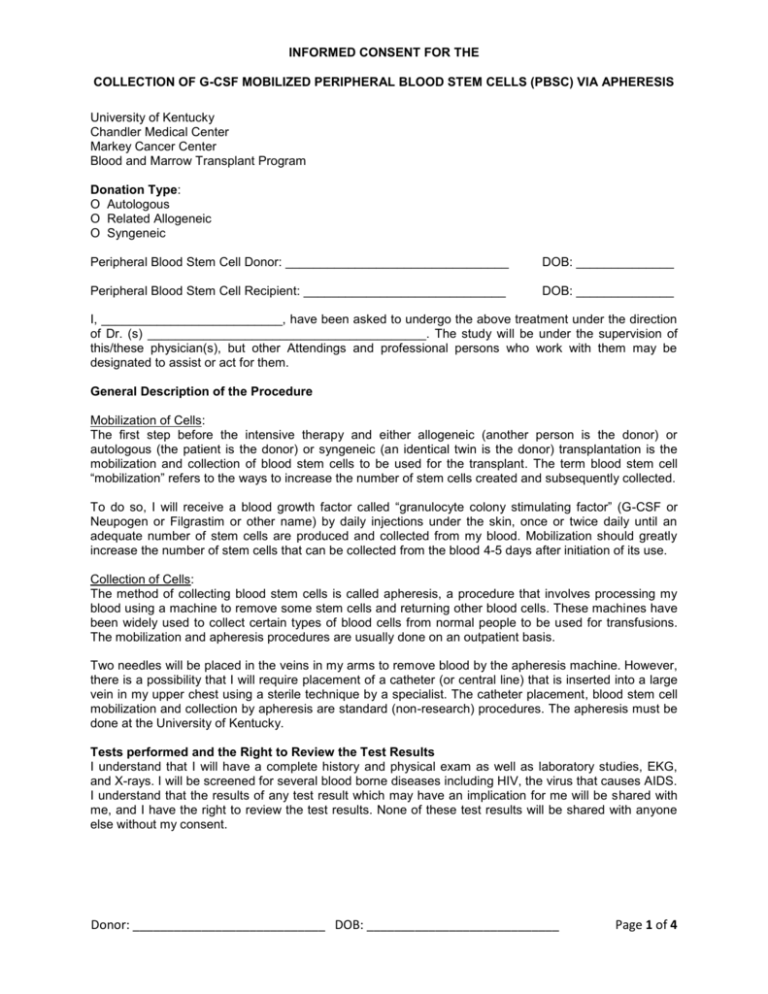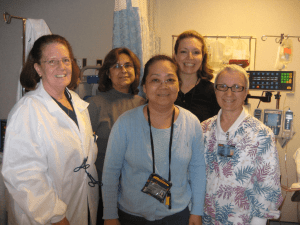informed consent for g-csf mobilized peripheral blood collection
advertisement

INFORMED CONSENT FOR THE COLLECTION OF G-CSF MOBILIZED PERIPHERAL BLOOD STEM CELLS (PBSC) VIA APHERESIS University of Kentucky Chandler Medical Center Markey Cancer Center Blood and Marrow Transplant Program Donation Type: O Autologous O Related Allogeneic O Syngeneic Peripheral Blood Stem Cell Donor: ________________________________ DOB: ______________ Peripheral Blood Stem Cell Recipient: _____________________________ DOB: ______________ I, __________________________, have been asked to undergo the above treatment under the direction of Dr. (s) ________________________________________. The study will be under the supervision of this/these physician(s), but other Attendings and professional persons who work with them may be designated to assist or act for them. General Description of the Procedure Mobilization of Cells: The first step before the intensive therapy and either allogeneic (another person is the donor) or autologous (the patient is the donor) or syngeneic (an identical twin is the donor) transplantation is the mobilization and collection of blood stem cells to be used for the transplant. The term blood stem cell “mobilization” refers to the ways to increase the number of stem cells created and subsequently collected. To do so, I will receive a blood growth factor called “granulocyte colony stimulating factor” (G-CSF or Neupogen or Filgrastim or other name) by daily injections under the skin, once or twice daily until an adequate number of stem cells are produced and collected from my blood. Mobilization should greatly increase the number of stem cells that can be collected from the blood 4-5 days after initiation of its use. Collection of Cells: The method of collecting blood stem cells is called apheresis, a procedure that involves processing my blood using a machine to remove some stem cells and returning other blood cells. These machines have been widely used to collect certain types of blood cells from normal people to be used for transfusions. The mobilization and apheresis procedures are usually done on an outpatient basis. Two needles will be placed in the veins in my arms to remove blood by the apheresis machine. However, there is a possibility that I will require placement of a catheter (or central line) that is inserted into a large vein in my upper chest using a sterile technique by a specialist. The catheter placement, blood stem cell mobilization and collection by apheresis are standard (non-research) procedures. The apheresis must be done at the University of Kentucky. Tests performed and the Right to Review the Test Results I understand that I will have a complete history and physical exam as well as laboratory studies, EKG, and X-rays. I will be screened for several blood borne diseases including HIV, the virus that causes AIDS. I understand that the results of any test result which may have an implication for me will be shared with me, and I have the right to review the test results. None of these test results will be shared with anyone else without my consent. Donor: ____________________________ DOB: ____________________________ Page 1 of 4 INFORMED CONSENT FOR THE COLLECTION OF G-CSF MOBILIZED PERIPHERAL BLOOD STEM CELLS (PBSC) VIA APHERESIS Risks G-CSF: The side effects of G-CSF injections are usually mild and short-lived, and may include low grade fever, mild nausea, abdominal cramping, headache, bone and joint pain, muscle aches, and rash. Rarely, allergic reactions, including wheezing and low blood pressure, may occur. Other side effects that are very rare but have occurred include lung or hearing problems, fluid retention, ruptures of the spleen, or blood clots. Though severe side effects have occurred, they are very uncommon and very unlikely to occur. Collection: Occasionally with blood stem cell collections, there may be a small, temporary decrease in the blood counts after the apheresis sessions. These decreases should not cause symptoms nor be noticeable to me. Also, some patients experience transient tingling sensations around the mouth or in the fingers and toes during the procedure. This effect is due to the anticoagulant (blood thinner) used during the procedure, and it responds to a slowing of the procedure or the use of “Tums” or other calcium-containing tablets taken by mouth. If a catheter is used to collect blood during the apheresis, infection can occur. This risk is reduced by good hygiene and care of the catheter. Blood clots also can form around the catheter, and this risk will be minimized by flushing the catheter after each use with blood thinners, or by rinsing the catheter with medicines that quickly dissolve blood clots. In patients who undergo apheresis without a catheter, there may be local discomfort or bruising where two needles have been placed in the arm veins. Local infections in the area of the venipuncture are extremely rare after apheresis. This risk is minimized by sterilely cleansing the skin before inserting the needles. Occasionally, a patient will experience temporary periods of low blood pressure during apheresis, but this problem can be corrected correctly quickly with infusions of saline (salt water). There is no risk of acquiring AIDS during an apheresis procedure since blood drawn and returned is my own and is processed within sterile, disposable equipment at all times during the procedure. Benefits Related Allogeneic and Syngeneic Donors: There is no direct benefit that may come to me by being a donor. Autologous: The cells collected may benefit me in the course of treatment. However, there is no guarantee that the collection will be adequate to either cure or lessen the severity of my disease or condition. Alternatives to Donation Alternative to donation include: ___________________________________________________________ ____________________________________________________________________________________ Alternative Modalities of Donation Include: _______________________________________________ ____________________________________________________________________________________ Donor: ____________________________ DOB: ____________________________ Page 2 of 4 INFORMED CONSENT FOR THE COLLECTION OF G-CSF MOBILIZED PERIPHERAL BLOOD STEM CELLS (PBSC) VIA APHERESIS Conditions of Storage and Disposal If I am donating the cells for someone other than myself, I accept that the cells will become the property and sole responsibility of the intended recipient listed on this consent. All rights and decisions regarding the cells and their disposition will be given to that intended recipient or his/her legal representative. If the cells I am donating are to be used at the University of Kentucky, it is possible that any unused cells may be placed in frozen storage. Because of this possibility, the intended recipient of the cells will be asked to sign a “Storage Agreement for Cryopreserved Blood and Marrow Cellular Products” by UK’s Stem Cell Processing Lab. This agreement will detail the terms for the storage, transfer, and disposal of any unused cells. The intended recipient will be given a copy of this signed agreement for his/her records. After Collection I have been advised to have someone accompany me in traveling home after my outpatient apheresis. After the procedure, I will be given a contact number to call if I feel ill. Authorization I authorize the collection facility medical and nursing staff to perform the apheresis procedure. I have had the opportunity to discuss this information with _______________________. I understand the procedure and why it is being done. Any questions I might have about this procedure and its risks and consequences have been answered to my satisfaction. I may contact Dr. ______________________ at __________________________ if I have any questions regarding this procedure or if I have any unexpected or severe side effects. I will receive a copy of this consent if I wish. ___________________________________________________ Signature of Patient ____________________ Date ___________________________________________________ Signature of Parent (or legally authorized representative) ____________________ Date ___________________________________________________ Signature of Witness ____________________ Date ___________________________________________________ Signature of Investigator ____________________ Date Donor: ____________________________ DOB: ____________________________ Page 3 of 4 INFORMED CONSENT FOR THE COLLECTION OF G-CSF MOBILIZED PERIPHERAL BLOOD STEM CELLS (PBSC) VIA APHERESIS Attachment A DONOR TESTING Standard Blood Tests Tests are done on your blood to make sure it is safe for you to donate PBSCs or bone marrow. Any increased risk might mean that you would not be allowed to donate, or that another method of collection may be necessary. These tests also protect the recipient getting your donation. Blood Tests for Diseases Your blood will be tested for infectious diseases including HIV, Hepatitis and West Nile Virus and others. If your check-up or blood test reveals anything that is not normal, you will be told. The University may be required by law to notify the state or local health agency if you test positive for Hepatitis B, Hepatitis C, or the virus that causes AIDS (HIV) or other infectious disease. Sickle Hemoglobin Your blood will be tested for sickle hemoglobin. This test may result in genetic information that is new to you. There have been reports of severe reactions to filgrastim in persons with sickle cell disease. If your blood test is positive for sickle hemoglobin, you will not be able to donate peripheral blood stem cells. However, you may still be asked to donate bone marrow for the recipient. Pregnancy Test If you are a woman of childbearing potential, you will be required to take a pregnancy test. You must not donate if you are pregnant. You must not take filgrastim if you are pregnant. This medication could cause serious problems for an unborn child. You must make sure that you do not get pregnant while taking filgrastim and for 48 hours after the last shot. Attachment B DEFINITIONS 1. Allogeneic donation: Donating cells for a person other than yourself 2. Anesthesia: Drug or drugs designated to relieve pain and/or cause loss of consciousness 3. Apheresis: A process where a machine divides blood into its separate parts. Blood is removed from one arm of the donor, passed through the machine, which separate out the needed type of cell(s), and return the remaining blood to the donor. Over time, the donor’s body naturally replaces the blood cells that are removed. 4. Blood forming cells: Cells found in the bone marrow and blood stream that rebuild your blood, bone marrow and the immune system 5. Central Line: A sterile tube put into one of the larger veins, usually in the groin area (femoral vein), the neck area (internal jugular) or just below the collarbone (subclavian vein). 6. EKG: Electrocardiography (ECG or EKG) is the recording of the electrical activity of the heart over time via skin electrodes. Electrodes on different sides of the heart measure the activity of different parts of the heart muscle. It is a good way to measure and diagnose abnormal rhythms of the heart. 7. Granulocyte colony stimulating factor (G-CSF): A drug that causes the bone marrow to produce more blood forming cells than usual. When these cells go into the blood stream they are often called peripheral blood stem cells (PBSC). They can be collected from the blood stream. GCSF is also called Neupogen and Filgrastim. 8. Mobilization: A method to increase the number of circulating peripheral blood stem cells 9. PBSC: Peripheral blood stem cells. This is another term for the blood forming cells circulating in your blood stream that can be taken by a machine. 10. Platelets: Special blood cells that help you stop bleeding by making clots. 11. Syngeneic donation: Donating cells for an identical twin 12. Syringe: Used to inject or withdraw a fluid. It has a hollow needle to break the skin and fluid is either injected into the body through the needle or fluids such as blood are withdrawn from the body. Donor: ____________________________ DOB: ____________________________ Page 4 of 4








